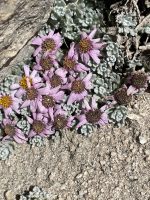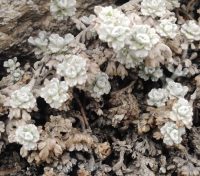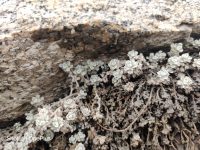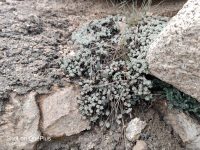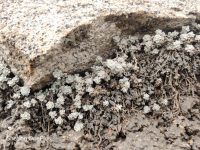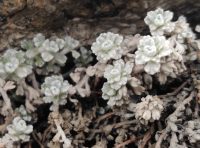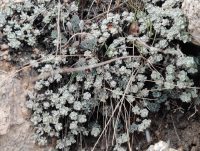|
Allardia nivea Hook.f. & Thomson ex C.B.Clarke, Compos. Ind.: 145 (1876) (syn: Waldheimia nivea (Hook.f. & Thomson ex C.B.Clarke) Regel ); Afghanistan to Tibet and W. & Central Himalaya: Afghanistan, Nepal, Tibet, West Himalaya as per POWO; Waldheimia vestita (Hook. f. et Thoms. ex C. B. Clarke) Pamp. : (Mixed thread): 17 posts by 6 authors. only two correct images as above.
Sharing some pictures I guess is Waldheimia vestita (Hook. f. et Thoms. ex C. B. Clarke) Pamp. shot on the way to Khardung La Leh on 22 August 2014 at around 14000 ft.
Or could it be Waldheimia nivea (Hook.f. & Thomson ex C.B.Clarke) Regel
Leaves do suggest W. vestita. I guessed so. Your last two in the set of 4 look W. glabra to me. I agree with … view on the two photographs, in the set of four, which show bright green leaves. These too Waldheimia vestita ? Attachments (2) What about the additional 2 pics? Dr Singh is correct that images 1020 and 1021 (the 3rd & 4th) are of a different species to the first two. I currently do not know how to tell W.vestita and W.nivea apart. Can anyone tell me what characteristics they use? I thought I was clear about W.glabra and W.tomentosa but have seen specimens in Ladakh (and Lahoul) which I am uncertain about. There are photos in ‘Flowers of the Himalaya’ of W.glabra, W.tomentosa and W.stoliczkai whilst W.nivea is illustrated in the Supplement but no mention of W.vestita. The author incorrectly state there were only 3 species of this genus in the Himalaya.
Dickore & Klimes list 5 species of Waldheimia from Ladakh incl. W.huegelii, which is new to me. They use the name W.tridactylites for what we are familiar with as W.glabra. Dvorsky has images of W.nivea and W.vestita at: http://www.butbn.cas.cz/ladakh/fotky/flora/ornamental_eng.html
Comparing with these shots, images 0216a and 0218a shot on the way to the Khardung La appear to be Waldheimia nivea – which is what I thought initially.
Stewart thought that W.stoliczkai might only be a glabrous form of W.tomentosa, as he had found glabrescent plants among a typical population of W.tomentosa. Stewart recorded W.nivea from Khardung La & Chortren Chen with altitudinal range of 3600-5600m; he records W.vestita at 5250m at Chortren Chen with an altitudinal range 4200-5200m.
I shall be looking into this further but would welcome input from others. Just for good luck,I see that ‘The Plant List’ has both W.glabra and W.tridactlites as accepted names! W.huegelii is an accepted name – published as a new record for India by Pusalkar, P.K. & Singh, D.K. 2004. Perhaps the authors belong to this group and can tell us how this species is distinguished from other Waldheimas, perhaps having images to post to help the process and recognition in the future? I think the differences listed in Flora of Brirish India are nicely illustrated by to images one above another in “The Most Beautiful Flowers of Ladakh” by M. Dvorsky at http://www.butbn.cas.cz/ladakh/ornamental_eng.html Hooker lists under Allardia
1. A. vestita: leaves 3-5 fid, 12-20 mm long, capitula on distinct peduncles, 20-25 mm across, pappus 6 mm long (needs confirmation)
2. A. nivea: leaves 3-fid, not more than 6 mm long, capitula sessile to subsessile, heads 12-19 mm across, pappus 4 mm long
Both leaves and heads are clearly visible in two adjacent photographs on the website.
A. glabra is easily separated by its glabrous (or sparsely woolly) leaves, 3-fid, 12-20 mm long, sessile larger heads 25-40 mm across, pappus 8 mm long.
A. tomentosa is very distinct with much larger (4-8 cm long) 1-2 pinnatifid leaves and peduncled much larger heads 5-8 cm across
Of the 4 above images above 3 and 4 belong to W. glabra while 1 and 2 fit with W. vestita. Thanks for information from Hooker, which whilst helpful and some of the content may still hold true, we must always remember that FBI is very much out-of-date and whilst Hooker and the other contributors did a remarkable job in the 19th century with strictly limited material and often scrappy, poorly collected specimens (many early collectors were not professional botanists) frequently with no field notes, not all the content can be relied upon. An important starting point and not to be neglected/forgotten but only that.
Similarly, Collet’s ‘Flora Simlensis’ is out-of-date and contain a number of errors. Of course all printed ‘floras’ are to an extent, out-of-date as soon as they are printed.
Sorry but if one accepts the key (based on Hooker) then the images are of Waldheimia nivea not W.vestitata having more or less sessile flower-heads cf. the peduncled ones of W.vestita.
I have recently come across even better images than the single one by our member you refer to, see the excellent photos of Jindrich Houska: http://botany.cz/en/waldheimia-nivea/ which have been named as W.nivea. So informative to have several images, showing habitat, habit and close-ups of flowers and foliage (though ideally even closer shots of petals, sepals, undersides of leaves, help provide further evidence). And one has to be mindful when photographing at 4000m or especially 5000m or so, it can be exhausting to work methodically. We need more people getting into the high mountains photographing its extraordinary flora.
From the images I have seen this past year, it seems W.nivea is much the commoner of the two species including being on the Khardung La, now reachable for a day excursion by vehicle from Leh.
I must get to examine some herbarium specimens of W.vestita close up.
Incidentally, neither W.vestita nor W.nivea are mentioned in ‘Flora of Lahaul-Spiti’ but this does not mean neither species occurs there, more likely that there are no specimens in the herbaria they inspected and they did not spend much time on the high passes were these tend to be found.
As W.nivea is found at such altitudes in Nepal, it is likely that this and perhaps W.vestita occur in Lahoul and or Spiti. Thanks … for prompting me to update my information. Yes in FBI W. glabra and W. tridactylites were kept under same taxon, but now considered distinct.
In fact all three W. stoliczkae, W. glabra and W. tridactylites have glabrous leaves. Former is distinct by its pinnately parted leaves, ligulate florets fertile with normal pappus, achenes 6-8 ribbed. of the latter two W. tridactylites has wholly glabrous plants, achenes not ribbed, sparsely papillate, pappus bristles 5-6 mm long, in W. glabra base of capitulum and sometimes peduncle are sparsely tomentose, achenesnot ribbed, glabrous and bristles 4 mm long.
Even Flora of USSR mentions about close similarity of W. stoliczkae and W. tomentosa former differing in complete absence of tomentose pubescence but concludes “The incomplete overlap of their ranges and absence of “intermediate” forms, nevertheless, provide a basis for retaining W. stoliczkae as a separate species”
Perhaps this key from http://www.pakbs.org/pjbot/41(2)/PJB41(2)555.pdf help further
1 + Cypselas non-ribbed ……….. 2
– Cypselas 6-8 ribbed ………… 3
2 + Cypselas glabrous. Pappus bristles 4.mm long ………………..… A. glabra
– Cypselas sparsely papillate. Pappus bristles 5-6 mm long ………. A. tridactyliles
3 + Cypselas papillate ……….… A. nivea
– Cypselas glabrous ……………. 4
4 + Carpopodium broad circular disc like, 355µm in diameter …… A. stoliczkae
– Carpopodium narrow angular ring like, 545µm in diameter .……. A. tomentosa
Waiting to learn more from you.
This is helpful, … but of course, unless one has a good quality pressed specimen to examine closely, most of these characteristics do not help us with only general photos, not in close-up.
May I request that during future travels, those taking a serious interest, take a ruler with them and for at least some shots, lay this down beside the specimen to aid a sense of scale and dimensions. This one can easily do with low-growing plants especially those in Ladakh, which often grown as isolated individual clumps.
It is harder amongst thick vegetation and for taller subjects. High quality close-ups of the flower-heads would also be useful. Once one gets into the routine of doing this, it does not take up much time and with today’s digital cameras it costs nothing- though one must crawl around on the ground to achieve this. Also, today’s digital cameras often mean that a tripod is often no longer essential for macro close-ups.
Mind you, for Waldheimias, which mostly grow at high altitude, it can be exhausting physically and mentally to work methodically. I recollect some 25 years ago on Baralacha La (between Lahoul & Rupshu district of Ladakh) having reached 4800m with the aid of a jeep, I started photographing plants with my camera using slide film. The light conditions were so bright, I knew that this would confuse the in-camera light metering system leading to badly exposed slides, so I needed to “bracket” the exposure (i.e. adjust to allow for this) yet I could not make myself do it! I am dedicated but my head was ‘light’. Mountaineers, faced with much higher altitudes (albeit, they ascend more steadily, on foot, so can adjust better) can easily make mistakes due to lack of oxygen. But I hope those able to access these high passes and photograph with wonderful species found amongst them, can see the value of trying to secure additional, close-up images for us to both admire (and wish we could have been there ourselves) and to aid the studying of India’s high Himalaya and borderlands of Tibet. Forgot to say, still need help about Waldheimia huegelii– a description please and how to distinguish it from other Waldheimia species in Ladakh (and elsewhere)? Ladakh was my dreamland, having visited (but only collected herbarium specimens as film photography was a luxury then) the place between 1970 to 1975 during my Ph.D days. I desperately wanted to visit the place again during last three four years but could not because of lack of company + my age now 71 + my heart on pacemaker. I wanted to click those plants with my camera, but still waiting. Any way I am in California till January, 2017.
Thanks, … Still you are doing a wonderful job.
I think … must also be in your company. .
1st set of images are of Waldheimia glabra, as per images and details herein. Yes first set is Allardia glabra (accepted name according to both POWO and COL) I had completely missed the difference in the leaves and thought both of them to be of the same species. .
Allardia nivea Hook.f. & Thomson ex C.B.Clarke ?? Yes matches with images at Waldheimia nivea (Hook.f. & Thomson ex C.B.Clarke) Regel . Waldheimia vestita in FOI: Link from FOI: Corrected:
. |
Disclaimer
1. For any mistake in identification or for becoming efloraofindia e-group member (for contributing towards building of efloraofindia or otherwise), pl. mail to indiantreepix@googlegroups.com or itpmods@googlegroups.com
2. For better viewing of species’ pages, colour scheme & formatting is being followed as: Description of the species, Details of other flora species on the same page, Uses/ harms, Distribution, Abundance/ Location/ Flowering time & date, Habit & habitat, Etymology & pronunciation, Other interesting information, stories etc., Others, Botanical names, Common names, Main point of discussion below, Discussion about Botanical names.
Navigation
- Award for eFloraofIndia
- Colour scheme & formatting
- Copyrights, Permissions, Citations
- eFloraofIndia appreciated
- Names of Plants in India site
- Flowersofindia site
- Posting Guidelines
- For members’ information
- Logo, Tagline, Acronym
- Volunteers required
- ‘Pitamah’ of eFloraofIndia
- ‘अजेय’ ‘Ajey’ of eFloraofIndia
- ‘Saarthi’ ‘सारथि’ of eFloraofIndia
- ‘Jewel’ of eFloraofIndia
- ‘Grassman’ of eFloraofIndia

